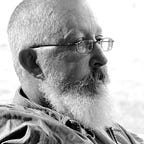What’s Your Point?
See Differently. Understanding and Using the Elements of Art.
Pastel Workshop.
Pure Pigment, Paste and Passion. Casey Klahn on the Pastel Medium.
What’s Your Point?
If the elements of art are the irreducible parts of a picture, certainly the very most basic element is the point. A point is an abstract occupant of space. To see its concrete form, you would make a dot with your pencil.
A dot has proportion and position. One dot is related to its position in space; you are considering positive and negative space. How big is the dot versus its piece of paper? You’ve imagined a relationship between the dot and the space remaining.
Multiple dots form a geometry. The night sky is the first classroom of the dot: we connect multiple dots to visualize shapes and figures. If you are a math nerd, you are hyper-ventilating right now about all of the possibilities of points, or coordinates, becoming planes and then a geometric shape. We get it.
We want to know the fundamental effects of the dot (a point’s manifestation) on our drawing. Here is what I wrote about the abstracted yellow and blue field painting that you see at the top of this chapter:
Abstract ideas. This abstract field study makes more sense the longer you look at it. A point, or dot, suggests relationships within a spacial area. By inference, these coordinates form more than the sum of their parts. Just as your mind knits together the subtle colors and horizontals in this painting, your mind brings the closure between coordinate elements (dots) in space.
You have gone from the abstract idea of a point, to completing a scene in your mind based on its component parts. This is the potential of the point: it is boundless in its power to suggest.
In the imposing fresco Disputa, by Raphael, it is easy to lose track of the meaning of the picture, so lost are we in the details and the huge scale. Reducing it to its “atomic level,” we can think about the properties of the humble point. How do the proportions of figures and groups signify their relationships to one another? The grouping of figures with the Godhead exist on the same plane of depth as the bottom grouping of theologians, however they are slightly larger in appearance, and are fewer in number.
Think about the positions of figures. Raphael is constrained by the artistic imperatives of the Renaissance to include depth of perspective; it must imitate a space that we can enter into. Before that, the classic portrayal of space involved hierarchy, where reality issued from heaven downward, and objects appeared upon a metaphysical ladder. Raphael is giving us a positional statement by relating the parts to one another and reconciling both Medieval and Renaissance realities. Raphael gives us his point of view, in more ways than one. The vault of heaven is narrow; the arguments in the subject of a theological debate exist on a much wider plain. God, the Father is prominent; Christ, the Son is incarnate and seated among the saints; the Holy Spirit is active within the church and illuminates the scriptures. The Holy Trinity and the saints preside above the group of Raphael’s contemporaries at the bottom of the scene.
Position and proportion are things at the atomic level of a picture. They abound from the simple point, but there is no limit to the possibilities from this simple beginning.
Casey Klahn is an artist, instructor and blogger. He blogs at The Colorist, and teaches workshops in the US and internationally on the artist’s process and on color.
http://thecolorist.blogspot.com/
Artwork in the header: Lies the Slope (detail). Pastel. Casey Klahn.
